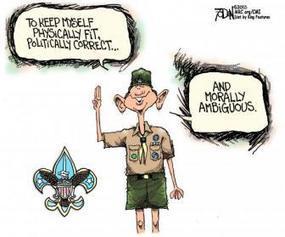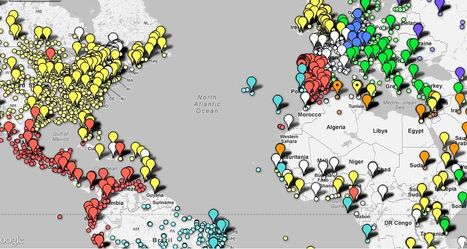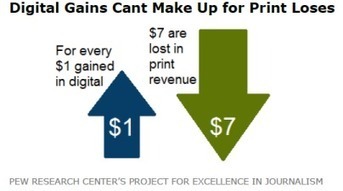 Your new post is loading...
 Your new post is loading...
On Sunday, New York Times reporter Jennifer Steinhauer explored how the Sunday network interview show producers and politicians “collaborate in a seductive ritual” to book the most powerful guests. But there’s a great sameness on the guest list: Sen. John McCain’s done 60 Sunday shows just since 2010.
Steinhauer says he’s a “dream guest” in part because he “compares members of his own party to deranged fowl” (wacko birds), at least at liberal networks: When it comes to a dream guest, program hosts say, Mr. McCain checks almost every box: a senior Republican senator who can speak authoritatively and contemporaneously on many issues, flies secretly to Syria, compares members of his own party to deranged fowl and yet is a reliable opponent of most Obama administration policies.
“What makes a good guest is someone who makes news,” said Mr. Wallace, the Fox host. “To make news, you have to be at the center of the news and willing to talk about it in a noncanned way, someone who always come to the shows ready to play.”
A look inside the operations of a major online publication—The Atlantic—and the evolving standards of how content is assigned, sourced, and paid for. The post consists of an e-mail exchange between Thayer and an Atlantic editor, where Thayer is asked if he would repurpose a previously published piece for the Atlantic’s website. He is not offered any money, but is told he will gain exposure since Atlantic’s site enjoys 13 million readers per month. For those familiar with the online world of publication, this exchange is hardly surprising or unusual. If you scan the posts at Who Pays Writers, you’ll see that $0 or maybe $50–$100 is common for very well-known sites. In fact, the more traffic a website gets, the more it can avoid payment by offering the carrot of exposure—which is indeed valuable and needed for some writers, but not all. Thayer, in response to the offer of pay through exposure, says: "Frankly, I will refrain from being insulted and am perplexed how one can expect to try to retain quality professional services without compensating for them. Let me know if you have perhaps mispoken [sic]."...
A Good PR Consultant Needs to Understand BusinessHuffington Post (blog). Once upon a time, the public relations business was relatively straightforward. You developed a campaign, then sold it into the media.... [PR consultant Sara Benwell makes a good point about the need for PR consultants to understand business. But, here's my response to her post about media relations: "I don't disagree with the need for PR to understand business. In my view, except for a CEO or president, an appointment notice is rarely "news" except in very limited circles immediately surrounding an organization (employees, trade). Your context here is media relations. The more important need is for business and PR to understand media. Media need news. They need action. They need stories that matter to their readers. Their readers need solutions to problems. They need to know organizations are making a difference to human beings. They don't need marketing. They don't need boardroom-speak, jargon or technical terminology. They don't need companies who don't practice corporate social responsibility or engage directly in communities or with individuals who read or watch media." Business understanding without understanding what the media need doesn't get you good media coverage. ~ Jeff]
Via Miguel Macedo
You read that correctly. There is no such thing as objectivity in journalism. And it's time to get over it. Every journalist has a political point-of-view and they don't magically check that at the door the minute they land a job. [Many would disagree with Andrew Kirell's point of view. I think it's an accurate reflection of journalism today ~ Jeff]
Via LPM Comunicação SA
Newsweek is ending its print edition. You'd think they'd express concern for their readers. You'd be wrong. Newsweek editor-in-chief Tina Brown and CEO Baba Shetty made a big announcement earlier this morning.
After 80 years as a weekly print magazine, they wrote, Newsweek plans to end its print edition in December and continue on only in a digital format.
But I noticed one GIANT omission in their statement. The entire statement is below. See if you can spot the omission....
[There's also another Key point missing from their statement which I mentioned in a comment to Brad Phillips' post. See if you can spot it too. ~ Jeff]
Google's "billions of clicks" are only half of the story. There is, on the one hand, an incredibly simple explanation for the shift in news organizations' attitude toward Google: clicks. Google News was founded 10 years ago -- September 22, 2002 -- and has since functioned not merely as an aggregator of news, but also as a source of traffic to news sites. Google News, its executives tell me, now "algorithmically harvests" articles from more than 50,000 news sources across 72 editions and 30 languages. And Google News-powered results, Google says, are viewed by about 1 billion unique users a week. (Yep, that's billion with a b.) Which translates, for news outlets overall, to more than 4 billion clicks each month: 1 billion from Google News itself and an additional 3 billion from web search. As a Google representative put it, "That's about 100,000 business opportunities we provide publishers every minute." Google emphasizes numbers like these not just because they are fairly staggering in the context of a numbers-challenged news industry, but also because they help the company to make its case to that industry. (For more on this, see James Fallows's masterful piece from the June 2010 issue of The Atlantic.) Talking to Google News executives and team members myself in 2010 -- the height of the industry's aggregatory backlash -- I often got a sense of veiled frustration. And of just a bit of bafflement. When you believe that you're working to amplify the impact of good journalism, it can be strange to find yourself publicly resented by journalists. It can be even stranger to find yourself referred to as a vampire. Or a pirate. Or whatever.... [Thoughtful post and reflections on the relationship between Google and news - JD]
For CNN anchor Wolf Blitzer, the promise of social media's impact on coverage of the Republican National Convention is simple:... It can turn reporting the news into a conversation. "Very often, I'll get a tweet from somebody who (notes a mistake) ... and I'll correct it right away," said Blitzer, who wasn't even on Twitter during the 2008 RNC and now has 540,000 followers. "I know it will change our coverage in Tampa." That's the kind of interaction a host of technology companies, media outlets and even convention organizers expect at the RNC; leveraging a host of social media platforms to place huge chunks of what happens here online.... [Interesting convention report, assuming it goes ahead - JD]
Social media use is growing fast and it's changing how people consume news. But there's still life in traditional media. The real choice for corporate communicators isn't putting resources in either traditional media or social media, but rather how do you get the right balance so that your company gets covered broadly and the stories have the most impact....
The magazine believes readers wants magazine-sized content throughout the day, not just at iPad time. Bloomberg Businessweek is testing a question: How well can magazine content work on the iPhone? Magazine companies have jumped feet first into the iPad marketplace, attracted to the idea that a lean-back medium like magazines would work well in a lean-back platform like tablets. But they’ve proven less interested in jumping onto iPhones and other smartphones — a target market that, while possibly less magazine-friendly, is also much larger....
The firing of an NBC News producer for a misleading edit of George Zimmerman's 911 call provides some unexpected lessons for those who deal with the media.... While the tape manipulation potentially had dramatic implications for the racially-charged Martin case -- it also carries two lessons for anyone who might find themselves interviewed by the media....
Newspaper Map | ✰ Find and translate all newspapers in the world ✰... [Impressive: NewspaperMap shows & translates 10,000+ world newspapers - JD]
The Wall Street Journal is tops among publications, but for individual journalists The New York Times holds the most influence. The recent Gorkana Group Survey of Financial Journalists sought to determine the most influential financial publications and journalists. To do so, it surveyed 349 financial journalists in the U.S. Among those reporters, The Wall Street Journal was the most influential, with nearly 72 percent nominating the paper....
Fifteen minutes after the first Tweet stating that the US military had found and killed Osama Bin Laden, CNN’s Wolf Blitzer was struggling on air. Blitzer could only react to what he (and everyone else) was reading on Twitter. For an excruciating amount of time Blitzer repeatedly explained that they couldn’t verify the reports. At last he confirmed what everyone had known for 20 minutes, that indeed Bin Laden had been killed. Social media has changed how we get our news. Today it’s fair to say that Twitter breaks news and television covers it....
|
The recent dustup between Nate Thayer and The Atlantic concerning payment (or lack thereof) for freelance writers has highlighted a fact obvious to many working in newsrooms across all platforms: Writers, as a profession, don’t make very much, especially considering the volume of work they perform on any given project. Charles Pierce said as much in a post for Esquire last week, chastising the Washington Post’s Ezra Klein for writing that much of the quality copy for news organizations is already being written for free by professionals who aren’t journalists, but rather “academics and business consultants and market analysts and former politicians.” These sources, Klein argues, “have the expertise that makes editors — and readers — trust them.” This is a defensible position, Klein argues, because most journalists are simply repackaging their sources’ point of view, and the sources aren’t paid for their contributions. But as Pierce notes, there’s much more to being a writer than expressing a point of view for the Opinion section...
When a helicopter crashed in a densely populated part of London around 8am today, next to one of the busiest trainlines in Europe and a large bus station, the news was always going to be broken, within seconds, by members of the public on Twitter, armed with camera phones.
Twitter user Craig Jenner was one of the first to put a picture on Twitter which was shared far and wide.
What happened next is indicative of the way the media are increasingly playing catch-up on such stories, moving from reporting to aggregating (or curating, if you must) - images, eye-witness accounts and videos. Journalists were asking to use the picture with a credit and were trying to get Jenner on the phone...
The massive shift toward digital media continues for new and traditional press outlets. Here’s how you can explain the change to your clients, including why it helps them. ...A few weeks ago, Newsweek became the latest magazine to announce it would cease publication of its print edition in favor of a digital-only format by year’s end. This isn’t the first announcement of its kind in 2012: SmartMoney Magazine killed its print publication in the summer, and rumors have swirled that the U.K.’s The Guardian is considering a switch to a digital-only edition. This trend will likely continue in the coming years as, according to the Pew Research Center’s statistics on print vs. online media, more than half of Americans receive their news from digital sources, and the number of people relying on social media exclusively for their news has doubled in the past two years. So how do public relations pros communicate this ever-changing landscape and its importance to clients?...
Newsweek cancels print edition and Clark Kent quits the Daily Planet. What's going on with the world of print? ...Add it to the announcement last week that rocked the print industry, Newsweek ending it’s print circulation, and it forms a bleak picture for print.
Why do I compare the Daily Planet’s loss to Newsweek’s digital shift?
Easy. Monkey see, monkey do.
My journalism drive came from what I saw. And what 12-year-old me saw was a top-shelf newspaper reporter who saved the world. And that inspiration is gone.
Newsweek, in print for 80 years, has been a constant in the ever-changing newsstand. And now it’s all in bits and bytes....
[My thought is that for every magazine or newspaper that fails a new and more relevant news innovation will take its place ~ Jeff]
When Americans first learn about a breaking news story, 83 percent seek out a second source to get more information, new research says. Half of them turned to a different type of platform (i.e., heard the news on TV then went online to read more) for follow-up, and of the people who went online, 60 percent turned to a traditional news outlet like The New York Times, CNN or Fox News....
Do newspapers have a shot at stepping ahead of their broadcast rivals as web video evolves? Our political conventions remind us that this is not the summer of love. But it may be the season we’ll remember as the summer of video. Certainly, video’s — news video’s — growth has been noteworthy for awhile. But now there’s a bursting of new news video forms, a hothouse of experimentation that is both refreshing and intriguing. The blossoming has implications far and wide, not just for “news,” but for tech companies like Facebook and television brands from Ellen to Piers to The View. Within it, we see the capability of non-TV companies to leapfrog the TV people. Just Monday, both The Wall Street Journal (“The Wall Street Journal wants its reporters filing microvideo updates for its new WorldStream”) and The New York Times made video announcements. A couple of weeks ago, the ambitious Huffington Post Live launched, hiring the almost unbelievable number of 104 staffers. In these three forays, and in the thinking in and around them, we see the boundaries of old media being slowly broken. We’re on the edge, finally, of new ways to both create and present news — and how to talk about the news.... [Trend for PR to follow closely - JD]
NEW YORK — A new study has found that YouTube has become a major platform for news, one where viewers are turning for eyewitness videos in times of major events and natural disasters. The Pew Research Center’s Project for Excellence in Journalism on Monday released their examination of 15 months of the most popular news videos on the Google Inc.-owned site. It found that while viewership for TV news still easily outpaces those consuming news on YouTube, the video-sharing site is a growing digital environment where professional journalism mingles with citizen content. “There’s a new form of video journalism on this platform,” said Amy Mitchell, deputy director of the Pew Research Center’s Project for Excellence in Journalism. “It’s a form in which the relationship between news organizations and citizens is more dynamic and more multiverse than we’ve seen in most other platforms before.”...
Pennsylvania’s Morning Call attributed a quote to Sen. Pat Toomey that was very different from his actual comment:
A story in Thursday’s paper incorrectly attributed the following quote to Sen. Pat Toomey, speaking about former Gov. Mitt Romney: “Don’t worry guys, he’s OK with me. I vetted him.” Toomey actually said: “I have had the privilege to know Gov. Romney for several years. I have studied his record very carefully. I have paid attention to this campaign. I don’t think there is any question he governed Massachusetts as a solidly fiscally conservative governor despite a very liberal Legislature.” [Sloppy journalism or what? JD]
What’s For Breakfast TV?Stunts & Celebrities and ‘Journalism Suffers’... The TV critics are assessing last week’s morning show stunts. “Television news now feasts on fame, the gaudier the better, with journalistic credentials a mere afterthought,” writes Newsweek/Daily Beast’s Howie Kurtz, who talked to two former “Today” show hosts about last week’s ratings grabbers — including Sarah Palin co-hosting last Tuesday — a response to Katie Couric‘s fill-in on ABC’s “Good Morning America.”...
A total of 71 titles appeared on the nation’s newsstands for the first time in March of 2012. Eleven of the titles were published with an intention to appear regularly on the stands where the lion’s share of the titles (60 to be exact) were specials and book-a-zines. The first eleven titles are those with a regular frequency, the rest are specials, book-a-zines and annuals …
In an era of real-time breaking news via Twitter how can we tell what is real and what isn't. Who do we really trust for news and information? It was a provocative question addressed by the SXSW 2012 panel sponsored by PR Newswire: When it comes to news and information, “Who do you trust?”...
...The question for PRs is whether a paywall reduces the exposure that clients could potentially get from gated stories in which they appear. Certainly if that media hit is restricted to paying subscribers, the pool of potential readers is more shallow. But, as the Journal points out, “free content is still plentiful online.” And paywall systems often offer a certain amount of content for free....
|



 Your new post is loading...
Your new post is loading...






























Great talk show insight, especially what makes a great guest like 'Wackobird' Whacker John McCain. DC is never dull. Or is it?